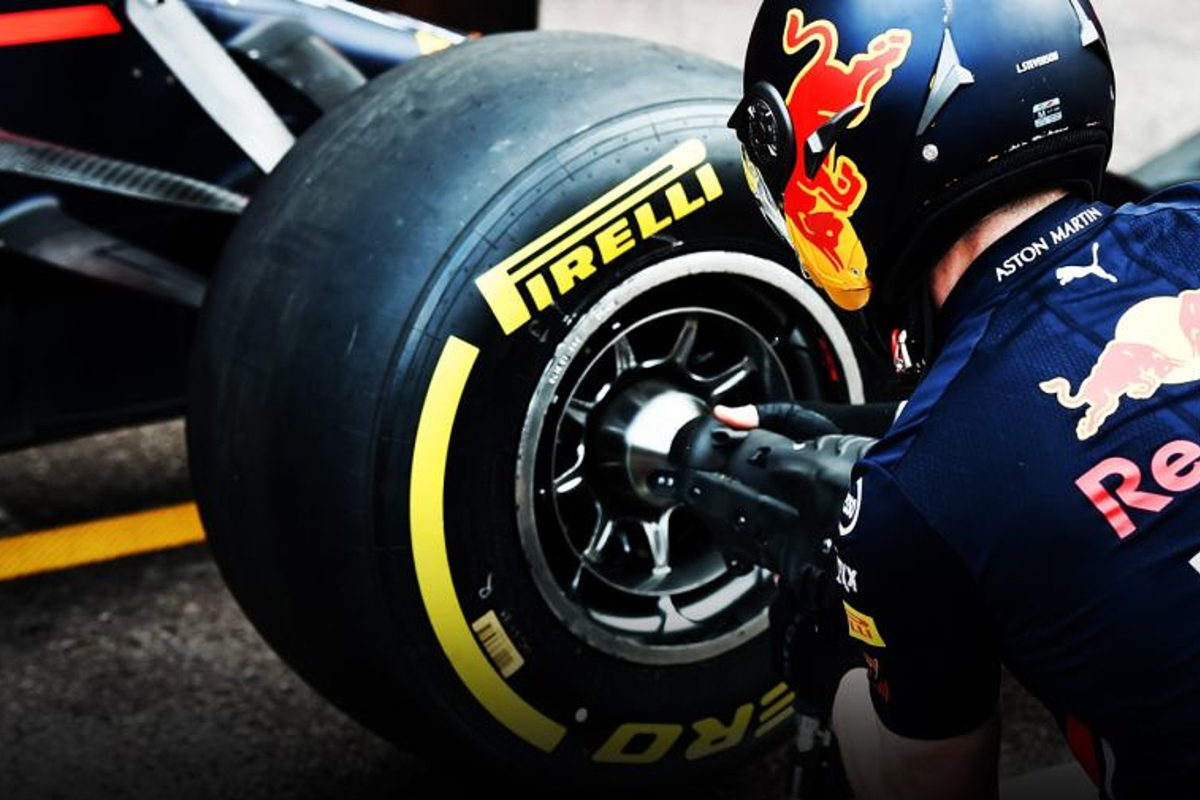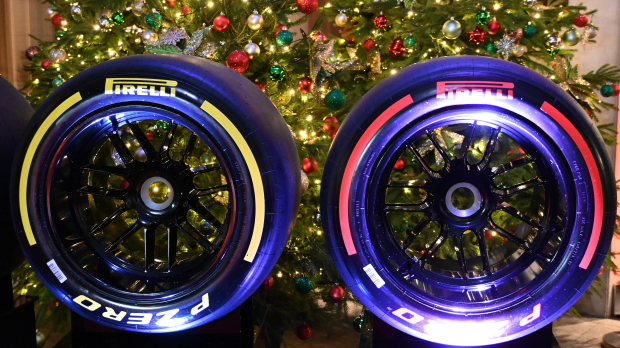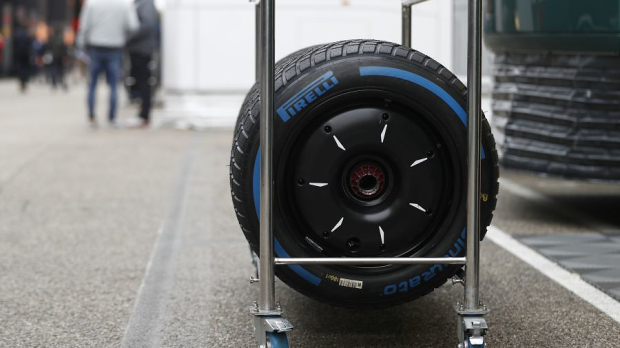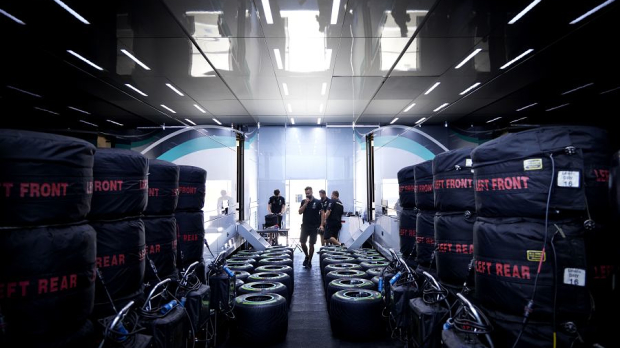
F1 tyres in 2023: Rules, changes, compounds and regulations
F1 tyres in 2023: Rules, changes, compounds and regulations

F1 is now into its 13th season with Pirelli as the sole tyre supplier but there are some key changes in place for the 2023 season.
First and foremost, Pirelli will begin 2023 with an evolution of the rubber used last year.
Although last year's major changes to the technical regulations meant that the tyres were unable to be tested ahead of the season with proper machinery, the manufacturer now has a full year of experience with which to remedy some of the complaints from teams – with the main one being that there was reduced grip at low speed, especially on the fronts, causing huge amounts of understeer.
The 2023 season started on Sunday March 5 with the Bahrain Grand Prix and you can get all the race-specific tyre info for that race by clicking here.
Adding some colour
The Italian manufacturer has been the tyre supplier for F1 since 2011 and has done a lot to aid the viewing experience of the public during that timeframe.
As well as providing strategy predictions based on information gathered across the early stages of each weekend, Pirelli also introduced different colours to the sidewalls of its tyres.
READ MORE: Alonso reveals only F1 driver with Vettel's phone number
Although commonplace now, this has massively improved the viewing experience with fans clearly able to tell which tyre compound each driver was running at any given time.
This system has gone through a number of changes over the years, but the current system of white walls for the hardest compound on a given weekend, yellow for the medium, and red for the soft, is the best yet.
Another major change introduced in 2022 was the shift from 13-inch wheels to low-profile 18-inch iterations. This massively altered the way cars used their suspension given the reduced travel in the tyre sidewalls.
F1 tyre changes for 2023
Pirelli has developed six types of tires for Formula 1 in 2023. This varies from the softest tire [C5] to the hardest rubber [C0].
The C0 is a new addition this term, adding an additional harder compound to what had previously been seen.
Teams will be able to pick from between 8 softs, 3 mediums, 2 hards across a Grand Prix weekend.
The compounds
Although there are six compounds of slick tyres in the range, as mentioned above, just three are available per weekend.
This means that while the C3 tyre could be nominated as the hard tyre one weekend and carry the white wall markings, it could become the soft or medium just one race later depending on the allocation decided by Pirelli.
At the post-season test last year where all six tyres were available, each carried individual markings. For the season itself, the standard red, yellow and white will be back in operation.
READ MORE: Hamilton urged to curb 'Oscar speech' antics
On any given weekend, the way teams use each compound differs considerably.
The red tyre is the softest compound that Pirelli carries. The tyre is the fastest over one lap but also has the highest level of wear.
The medium tyres can be recognised by the yellow stripes. This is often viewed as the strongest tyre for a race due to its often long lifespan and a considerable pace advantage over the hard equivalent.

The white-walled hard tyres generally can last longer than the other compounds.
Lacking the pace of the soft option, this compound puts a driver at a disadvantage over a single lap or a short stint but can yield benefits across a longer period.

The sport also needs tires which can be used when it is raining. The green-walled tyre, the intermediate tyre has grooves in the rubber.
This allows drivers to drive on a wet track, with the grooves draining the water. But if the track is too wet, the intermediate will also lose its grip.
That's when the rain tyre comes into play. The blue-walled tyre has far deeper treads and is designed to withstand the toughest and wettest conditions.
In recent years, however, when the conditions have required the wet tyre, the race has often been red-flagged due to the extreme lack of grip and visibility.
The rules for this season
During the race, a driver is required to use two different types of tyres. This rule is pushed aside if rain intervenes and wet or intermediate tyres are required.

After each free practice, the teams have to hand in two sets of tyres, leaving only seven for qualifying and the race.
Of those two sets, one will be returned for Q3. The advantage for the slower teams is that they have an extra set of rubber left over for the race. Each driver also has four sets of intermediates and three sets of rain tyres.
Heat blankets
For a driver, keeping the tyres at the right temperature is one of the most important tasks during racing. If the right temperature is not reached, the car will lack grip and this can result in a potentially race-ending crash.
To help the drivers get started, the tyres are placed in the heat blankets before a session.
However, as the sport wants to phase out blankets, the temperature has been lowered from 100 degrees Celsius to 70.
The intention was to drop this further to 50 degrees in 2023, but following a trial run in the United States, the teams did not think it was safe to drive on track at that temperature.
As a compromise, Pirelli has raised the limit to 70 degrees Celsius for the 2023 season. But where in the past the tires were in the heat blankets for three hours before a session, this is only allowed two hours for the relevant session next year.
READ MORE: Pirelli warned it faces a big challenge
Related news

Superstar rapper partners with F1 in surprise venture

Brundle demands drastic F1 change with drivers divided

F1 skid blocks explained: Why were Hamilton and Leclerc disqualified from United States GP?

F1 stars to feature in Netflix LIVE STREAM with brand new Las Vegas tournament
Most read

FIA take action after Verstappen track limits mishap

F1 News Today: FIA make changes as Mercedes receive double penalty and Horner curses bad luck

Red Bull to replace driver at Abu Dhabi Grand Prix

Stroll issues Alonso Aston Martin contract verdict

Horner takes aim at Kravitz with savage jibe at Sky Sports pundit
F1 Standings

Drivers
- Charles Leclerc
- Carlos Sainz
- Lando Norris
- Oscar Piastri
- Pierre Gasly
- Esteban Ocon
- Sergio Pérez
- Max Verstappen
- Alexander Albon
- Logan Sargeant
- Lewis Hamilton
- George Russell
- Nico Hülkenberg
- Kevin Magnussen
- Fernando Alonso
- Lance Stroll
- Valtteri Bottas
- Zhou Guanyu
- Nyck De Vries
- Liam Lawson
- Daniel Ricciardo
- Yuki Tsunoda
Races
-
 Gulf Air Grand Prix of Bahrain 2023
Gulf Air Grand Prix of Bahrain 2023
-
 Saudi Arabian Grand Prix 2023
Saudi Arabian Grand Prix 2023
-
 Grand Prix of Australia 2023
Grand Prix of Australia 2023
-
 Grand Prix of China 2023
Grand Prix of China 2023
-
 Grand Prix of Azerbaijan 2023
Grand Prix of Azerbaijan 2023
-
 Miami Grand Prix 2023
Miami Grand Prix 2023
-
 Qatar Airways Gran Premio Del Made In Italy E Dell'emilia Romagna 2023
Qatar Airways Gran Premio Del Made In Italy E Dell'emilia Romagna 2023
-
 Grand Prix of Monaco 2023
Grand Prix of Monaco 2023
-
 AWS Gran Premio de España 2023
AWS Gran Premio de España 2023
-
 Grand Prix du Canada 2023
Grand Prix du Canada 2023
-
 Grand Prix of Austria 2023
Grand Prix of Austria 2023
-
 Aramco Grand Prix of Great Britain 2023
Aramco Grand Prix of Great Britain 2023
-
 Grand Prix of Hungary 2023
Grand Prix of Hungary 2023
-
 Grand Prix of Belgium 2023
Grand Prix of Belgium 2023
-
 Heineken Dutch Grand Prix 2023
Heineken Dutch Grand Prix 2023
-
 Grand Prix of Italy 2023
Grand Prix of Italy 2023
-
 Grand Prix of Singapore 2023
Grand Prix of Singapore 2023
-
 Grand Prix of Japan 2023
Grand Prix of Japan 2023
-
 Qatar Grand Prix 2023
Qatar Grand Prix 2023
-
 Grand Prix of the United States 2023
Grand Prix of the United States 2023
-
 Gran Premio de la Ciudad de Mexico 2023
Gran Premio de la Ciudad de Mexico 2023
-
 Rolex Grande Prêmio de São Paulo 2023
Rolex Grande Prêmio de São Paulo 2023
-
 Heineken Silver Las Vegas Grand Prix 2023
Heineken Silver Las Vegas Grand Prix 2023
-
 Grand Prix of Abu Dhabi 2023
Grand Prix of Abu Dhabi 2023
About GPFans
GPFans is a multi-platform, multi-language brand dedicated to Formula One coverage. We bring you all the ins and outs of the sport, 24/7, everything from up-to-the-minute news and features to the latest viral stories and clips.We believe that a new generation of exciting, outspoken drivers will make F1 more popular than ever before, and we want to give our users access to as much of their heroes as possible, on and off the track. From Lewis Hamilton to Max Verstappen, Daniel Ricciardo to Sebastian Vettel, we provide in-depth analysis of every every Grand Prix in the season, from Australia to Abu Dhabi.
With Formula One under the new ownership of Liberty Media, how the sport is being covered is evolving, and GPFans will look to be at the heart of this progression into new media, as one of the fastest-growing sites covering the king of motorsports.
Follow us on your favorite social media channel
Corporate & Media
 Innovatieweg 20C
Innovatieweg 20C7007 CD, Doetinchem, Netherlands
+31645516860













 Gulf Air Grand Prix of Bahrain 2023
Gulf Air Grand Prix of Bahrain 2023  Saudi Arabian Grand Prix 2023
Saudi Arabian Grand Prix 2023  Grand Prix of Australia 2023
Grand Prix of Australia 2023  Grand Prix of China 2023
Grand Prix of China 2023  Grand Prix of Azerbaijan 2023
Grand Prix of Azerbaijan 2023  Miami Grand Prix 2023
Miami Grand Prix 2023  Qatar Airways Gran Premio Del Made In Italy E Dell'emilia Romagna 2023
Qatar Airways Gran Premio Del Made In Italy E Dell'emilia Romagna 2023  Grand Prix of Monaco 2023
Grand Prix of Monaco 2023  AWS Gran Premio de España 2023
AWS Gran Premio de España 2023  Grand Prix du Canada 2023
Grand Prix du Canada 2023  Grand Prix of Austria 2023
Grand Prix of Austria 2023  Grand Prix of Hungary 2023
Grand Prix of Hungary 2023  Grand Prix of Belgium 2023
Grand Prix of Belgium 2023  Grand Prix of Singapore 2023
Grand Prix of Singapore 2023  Grand Prix of Japan 2023
Grand Prix of Japan 2023  Qatar Grand Prix 2023
Qatar Grand Prix 2023  Gran Premio de la Ciudad de Mexico 2023
Gran Premio de la Ciudad de Mexico 2023  Rolex Grande Prêmio de São Paulo 2023
Rolex Grande Prêmio de São Paulo 2023  Grand Prix of Abu Dhabi 2023
Grand Prix of Abu Dhabi 2023